
Free Airdrop Season 7 is LIVE! Answer fun questions or do simple tasks to earn rewards from the $30K BitDegree prize pool. Participate Now ! 🔥
If you’ve ever asked, “What’s the best place to buy Bitcoin?”, chances are you got a bunch of recommendations for top centralized exchanges like Binance or Bybit. But are exchanges really the be-all and end-all of crypto buying options? If you’re wondering whether there are any alternatives, this Paxful review is for you!
Paxful is the largest and longest-running peer-to-peer (P2P) crypto marketplace. Unlike centralized exchanges that act as mediators between traders, Paxful lets users buy and sell crypto to each other directly with 300+ available payment methods.
It goes without saying that wandering off the beaten path comes with both pros and cons. Is Paxful legitimately a better alternative to the aforementioned exchanges (or their own P2P marketplaces, for that matter)? And is it actually safe for your average seller or buyer? There’s only one way to find out!
Verdict at a Glance:
Paxful is a powerful and user-friendly crypto P2P trading marketplace with 300+ methods of payment, including a large selection of fiat currencies. However, it has high seller fees and is restricted in a number of countries, such as the US.
Pros
- Large selection of payment methods
- Broad regional adaptability
- Additional services for businesses
- Stringent security measures
- Generous rewards programs
Cons
- Only 4 cryptocurrencies for trading
- High seller fees
- Not available in the US
Table of Contents
- 1. Paxful Review: Quick Overview
- 2. Paxful Alternatives
- 3. Who’s Paxful For?
- 4. Advantages
- 5. Limitations
- 6. Trading Tools
- 7. Fees and Limits
- 8. User Experience
- 9. Security
- 10. Customer Support
- 11. Localization and Regional Adaptability
- 12. Bonuses and Special Offers
- 13. How to Use Paxful
- 13.1. How to Create a Paxful Account
- 13.2. How to Deposit on Paxful
- 13.3. How to Withdraw From Paxful
- 14. Comparison to Other Popular Exchanges
- 14.1. Paxful VS Bybit
- 14.2. Paxful VS KuCoin
- 15. Conclusions: Is Paxful Right for You?
Paxful Review: Quick Overview
Before we dive in, here’s a snapshot of Paxful’s key features and characteristics:
Type | P2P trading platform |
Is Paxful safe? | YES |
Best for | Intermediate to advanced traders |
Established in | 2015 |
Headquarters | Wilmington, US |
Availability | 140+ countries |
Licenses | FinCEN, OFAC |
KYC Verification | YES (mandatory for deposits, withdrawals, and buying/selling) |
Security | 2FA, encryption, independent escrow |
Features | Buying/selling crypto with 300+ payment methods |
Supported Coins | BTC, ETH, USDT, USDC |
Funding Methods | Credit/debit card, bank transfer, Paypal, SEPA, Amazon gift card, and 300+ more |
Fees | 1-5% for sellers, 0% for buyers |
Fiat Support | YES |
Customer Support | Email, live chatbot, knowledge base |
Privacy & Anonymity | No anonymity features |
Table: Quick overview of Paxful
Since this table doesn’t fully answer the question, “What is Paxful?” on its own, the one takeaway I’d like to highlight once again is that Paxful isn’t technically a crypto exchange but a P2P marketplace, which means that it operates differently and has its own distinct features and advantages. But we’ll get into all that later!
Paxful Alternatives
If P2P platforms like Paxful aren’t the most conventional way of buying and selling crypto – why not take a look at the go-to avenues, as well, and see how they compare? Here are the top Paxful alternatives you should keep an eye on:
- Bybit. This exchange, with over 10 million users across 160+ countries, supports multiple trading types and has its own extended Web3 ecosystem, as well as a built-in P2P marketplace where you can trade 300+ assets with as many payment methods.
- KuCoin. Launched in 2017, KuCoin has margin, pre-market, futures, and P2P trading. The latter allows you to buy or sell 5 crypto coins with zero fees using one of the available 100+ payment methods. It has stringent security measures, including escrow services.
Unlike Paxful, these two exchanges offer traditional crypto trading and direct buying options alongside the P2P marketplace.

|

|
|
|---|---|---|
| More Advanced Users | Best for Buying & Selling Crypto with Small Fees | |
| South Korea, United Kingdom, Ukraine, Turkey, +160 more | United Kingdom, India, Russia, Mexico, + 150 more | |
| See All Coupons of Best Exchanges | See All Coupons of Best Exchanges | |
| A popular crypto derivatives exchange with some super-low trading fees. | A reliable and well-established cryptocurrency exchange platform. | |
|
See TOP10 Brands
Read review |
See TOP10 Brands
Read review |
Table: Bybit and KuCoin comparison
If maximum flexibility is what you’re after, Bybit and KuCoin would have an edge over our platform in question – but how does their P2P functionality compare to Paxful's? That said, later in this review, you’ll find a detailed side-by-side comparison chapter where we put these platforms head to head.
📚 Read More: Best Cryptocurrency Exchange

Did you know?
All Crypto Exchanges may look similar to you but they're NOT all the same!
Who’s Paxful For?
At this point, you’re probably dying to find out – what kind of user is this platform meant for, anyway? And could that user be you? Let’s cut to the chase and take a peek at who’s most likely to use and benefit from Paxful:
- Professional crypto traders. Paxful is an excellent platform for traders looking to maximize their profits through arbitrage – a strategy that involves buying low in one market and selling high in another.[1]
- International crypto traders. While most top exchanges offer an option to buy/sell crypto with fiat currency, Paxful stands out with its massive selection of 100+ local currencies and different payment methods that make the platform accessible and convenient to users worldwide.
- Crypto sellers. Paxful specializes in catering to crypto vendors, offering various perks and benefits like trade analytics and VIP support for high-volume sellers.
- Small businesses. Aside from the P2P marketplace, Paxful comes with a few adjacent products and services that allow businesses to integrate a crypto payment gateway or a crypto “kiosk” on their website.
As you can see, that’s quite a diverse range of demographics. If you see yourself among them (right now or at some point in the future), this Paxful review should definitely be on your reading list!
Advantages
To kick off this Paxful review on a high note, here’s a list of the platform’s selling features and strong suits:
- Large selection of payment methods;
- Broad regional adaptability;
- Additional services for businesses;
- Stringent security measures;
- Generous rewards programs.
One of the best things about Paxful is, hands down, its massive selection of payment methods. On your average centralized exchange, you’re pretty much stuck with a bank transfer, credit/debit card, or some flavor of third-party payment methods like PayPal. Paxful, on the other hand, spoils its users with over 300+ payment methods.
The aforementioned selection also happens to include over 100 fiat currencies, which is where another benefit comes into the picture. No matter where you live, as long as Paxful is available in your country, you can expect to be able to pay in your local currency. In addition, the platform supports 49 languages.
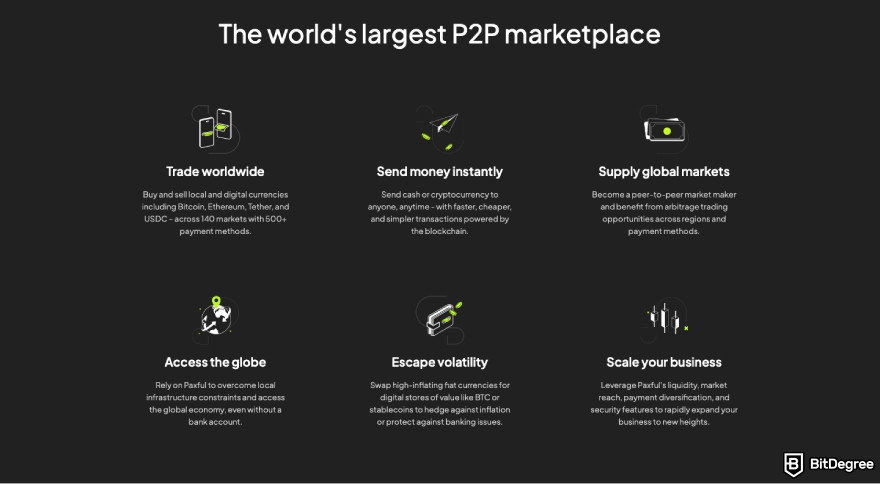 As I noted in the previous chapter, Paxful has a lot to offer for businesses, too. If you want to provide your customers with an option to pay with crypto, the platform comes with its own merchant payment gateway you can set up on your website. And if you want to go the extra mile, there's the Paxful Kiosk integration your customers can use to buy crypto directly on your website before spending it.
As I noted in the previous chapter, Paxful has a lot to offer for businesses, too. If you want to provide your customers with an option to pay with crypto, the platform comes with its own merchant payment gateway you can set up on your website. And if you want to go the extra mile, there's the Paxful Kiosk integration your customers can use to buy crypto directly on your website before spending it.
It’s no secret that P2P marketplaces are considerably riskier than crypto exchanges,[2] but the platform still lays out as many safety nets as possible. Phone verification and KYC are mandatory for both sellers and buyers. On top of that, the platform employs advanced escrow services and a large team of moderators to solve potential disputes.
One feature Paxful does have in common with most centralized exchanges is a choice of rewards initiatives. The Affiliate program lets you earn a commission not only from your own referees but the people they referred, too. What’s more, high-volume users can enter the Traders’ program and get perks like priority support for disputes and extra promotion for their sell offers.
Limitations
Of course, it’s not all sunshine and rainbows – no platform is perfect, and Paxful is no exception. Based on my own experience, as well as other users’ Paxful reviews, these are the main cons that drag down its ratings:
- Only 4 cryptocurrencies for trading;
- High seller fees;
- Not available in the US.
One of the key differences between P2P marketplaces and crypto exchanges is that the former typically have a much smaller selection of cryptocurrencies. Even though Paxful offers plenty of coins and tokens as a payment method, you can only buy or sell 4 assets: BTC, ETH, USDT, and USDC.
Another drawback is that Paxful can be quite pricey for sellers. In contrast with buying crypto, which is completely free, selling entails an escrow fee from 1% to 5%, depending on the payment method.
Payment Group | Sell | Buy |
|---|---|---|
All Non-Gift Card Payments | 1% | no fee |
Gift Card Payments | 5% | no fee |
Table: Escrow fees
Finally, while Paxful operates in over 140 countries, the US is not on the list – which is a bit ironic given that the platform is an American company and holds a number of licenses relevant to the US market.
Trading Tools
Now that you've enjoyed the appetizer, it’s time to dig into the main course of this Paxful review! To begin with, here’s a list of the platform’s main features:
- Buying/selling crypto on the P2P marketplace;
- Paxful Pay;
- Paxful Kiosk.
Paxful works by connecting crypto buyers and sellers and letting them trade with each other directly – the same way you would on your typical secondhand marketplace, for instance.
On this platform, you can only buy or sell 4 cryptocurrencies:
Such a sparse selection isn’t unique to Paxful, by the way – crypto P2P marketplaces typically offer only the few most popular assets because of regulatory constraints and the fact that, since users tend to buy from local sellers in their own region, there’s just not enough market for most of the lesser-known altcoins.
What Paxful lacks in crypto selection, it makes up for with a much more impressive list of 300+ payment methods. You can choose between paying with other cryptocurrencies, gift cards from a number of stores (such as Amazon or iTunes), wire transfer, SEPA, or pretty much every third-party provider you can think of.
 That said, picking a less popular payment option might limit the number of offers, so keep that in mind if you’re feeling overwhelmed! Nine times out of ten, it's probably best to stick with the mainstream options.
That said, picking a less popular payment option might limit the number of offers, so keep that in mind if you’re feeling overwhelmed! Nine times out of ten, it's probably best to stick with the mainstream options.
Paxful is more than just a P2P marketplace, however – it’s an entire ecosystem with a mission to increase crypto adoption throughout the world. And what better way to achieve this than a custom merchant payment gateway? With Paxful Pay, any business can set up a crypto payment option on their website – with no fees or chargebacks to worry about.
As of the moment of writing, Paxful Pay is only available for WordPress. However, they have already announced that the service will be available with Shopify, Squarespace, Magento, and Wix integrations in the future.
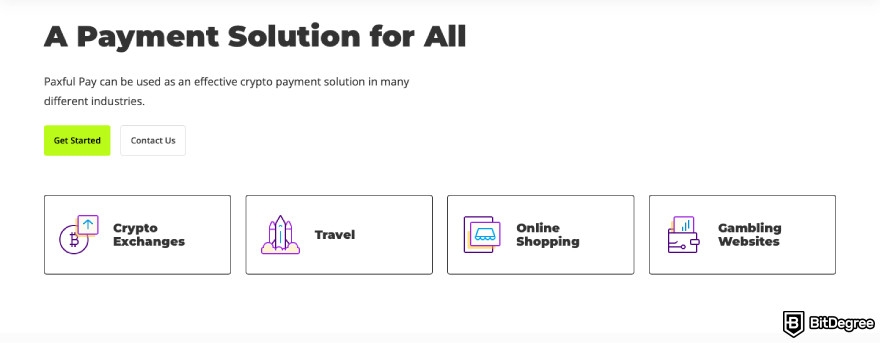 But wait – there’s more! Let’s say you’re a customer who prefers paying with crypto, but you find yourself with an empty wallet just now. Precisely for cases like these, Paxful offers a “Kiosk” service – a sort of mini-exchange integration businesses can put up on their website so that customers can buy some crypto before spending it. In exchange, the business earns a 2% commission on every sale.
But wait – there’s more! Let’s say you’re a customer who prefers paying with crypto, but you find yourself with an empty wallet just now. Precisely for cases like these, Paxful offers a “Kiosk” service – a sort of mini-exchange integration businesses can put up on their website so that customers can buy some crypto before spending it. In exchange, the business earns a 2% commission on every sale.
Both Paxful Pay and Kiosk include the same 300+ payment options as the P2P marketplace.
Fees and Limits
How much does it cost to buy or sell crypto on Paxful? Given the array of payment methods, you’d expect the answer to be more complicated – but in reality, the system is quite streamlined and simple.
Being a P2P marketplace, Paxful doesn’t have the typical maker/taker trading fees. Instead, the main expenses come from escrow services.
Type | Fees |
|---|---|
Buying | Free! |
Selling | 1% via gift cards, 5% via other payment methods |
Crypto Conversion | 0.2% |
Deposit | Free! |
Withdrawal | External wallet: dynamic network fees + Paxful fees capped at $2-25; internal wallet: 1% |
Table: Paxful fees
As you can see, buyers are the real winners here – you can buy crypto on Paxful completely free of charge! The selling fees are pretty high compared to those on major crypto exchanges, though.
Deposits are free and unlimited, while withdrawal fees depend on the cryptocurrency. These fees are capped: for example, if you’re withdrawing Bitcoin, you won’t pay more than $25. Tether withdrawal fees are capped at $5, while Ethereum and USDC withdrawal fee cap is $2.
Withdrawing to another Paxful Wallet (AKA, internal withdrawals) has no network fee but still costs 1%. The minimum amount you can withdraw is $1. Withdrawal limits depend on the verification level.
User Experience
Both the Paxful P2P marketplace and the website itself feature an intuitive and user-friendly interface. You can access the marketplace from a number of different pages, either by selecting the asset and the payment method outright or going to the P2P platform first and choosing the filter parameters.
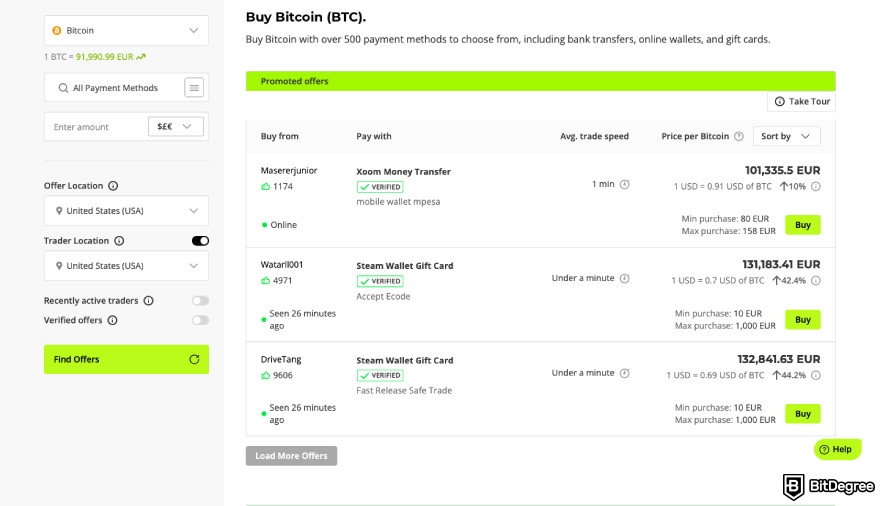 You’ll find those filters on the left-side panel. Paxful differentiates between the trader location and the offer location. You can choose to display only verified offers or even filter out traders who haven’t been active recently. The sorting options include price and the average trade speed.
You’ll find those filters on the left-side panel. Paxful differentiates between the trader location and the offer location. You can choose to display only verified offers or even filter out traders who haven’t been active recently. The sorting options include price and the average trade speed.
The dashboard is equally informative and easy to use, with one-click access to the offer inbox, favorite offers, recent trade partners, and trade statistics. On the top menu bar, you’ll find your Paxful Wallet with the list of assets.
Speaking of the website, I found the Bitcoin price calculator to be a nice touch. It shows you the current price of BTC in any of the available 100+ fiat currencies, which is pretty neat when you just want a quick price conversion without leaving the website.
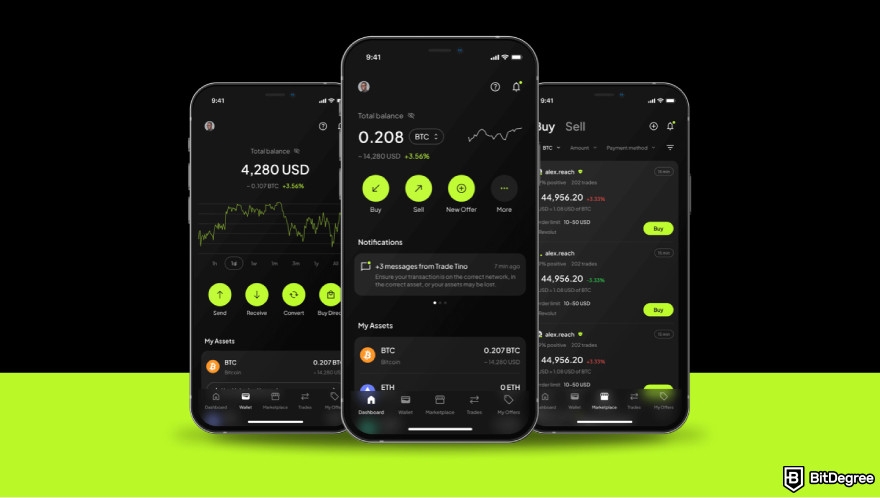 When it comes to user experience, this Paxful review wouldn’t be complete without a word or two on the mobile app. Even though the website somewhat misleadingly refers to it as a “Bitcoin Wallet”, it’s actually a fully-featured mobile Paxful app. You can buy or sell all 4 available coins and deposit or withdraw your funds. The app is available for both iOS and Android.
When it comes to user experience, this Paxful review wouldn’t be complete without a word or two on the mobile app. Even though the website somewhat misleadingly refers to it as a “Bitcoin Wallet”, it’s actually a fully-featured mobile Paxful app. You can buy or sell all 4 available coins and deposit or withdraw your funds. The app is available for both iOS and Android.
Security
Enough about usability for now – it’s time for the million-dollar question. Is Paxful legit and safe enough to use?
Truth is, I can’t really give you a straightforward answer here. The security of crypto P2P marketplaces is quite a multi-faceted issue. Unlike centralized exchanges where trading is an automated process recorded on the order book, P2P marketplaces have users trade crypto with each other the old-fashioned way: manually.
As you can imagine, this introduces the inherent risk of one party backing out on their end of the deal and the other one ending up empty-handed. With that in mind, P2P marketplaces like Paxful have to rely on alternative safety nets. This platform has 3 main buffers between honest users and bad actors (in that order):
- Identity verification;
- Escrow service;
- Dispute moderation team.
While technically, P2P trading in its basic form doesn’t require KYC, centralized P2P marketplaces often do – and Paxful is no exception. You won’t be able to trade crypto here (or even access your wallet) without passing identity verification first. If you want to increase your trade limits, you’ll have to submit proof of address in addition to basic KYC.
Level | Verification Needed | Limit Per Trade | Trade Volume Lifetime Limit | Send From Wallet Lifetime Limit |
|---|---|---|---|---|
1 | Email, Phone, and ID | $10,000 | $10,000 | $10,000 |
2 | Proof of Address | $50,000 | Unlimited | Unlimited |
3 | Enhanced Due Diligence | More than $50,000 | Unlimited | Unlimited |
Table: Paxful limits
Level 2 verification also removes the 0.002 BTC requirement for your offers to be visible in the marketplace.
KYC is the most basic, garden-variety security measure any crypto trading platform should have. However, when it comes to P2P trading, it’s just the tip of the iceberg. The real heavy lifting is done by escrow – a third-party service that holds the crypto in its custody until the transaction is complete, meaning both the buyer and seller have fulfilled the trade conditions.
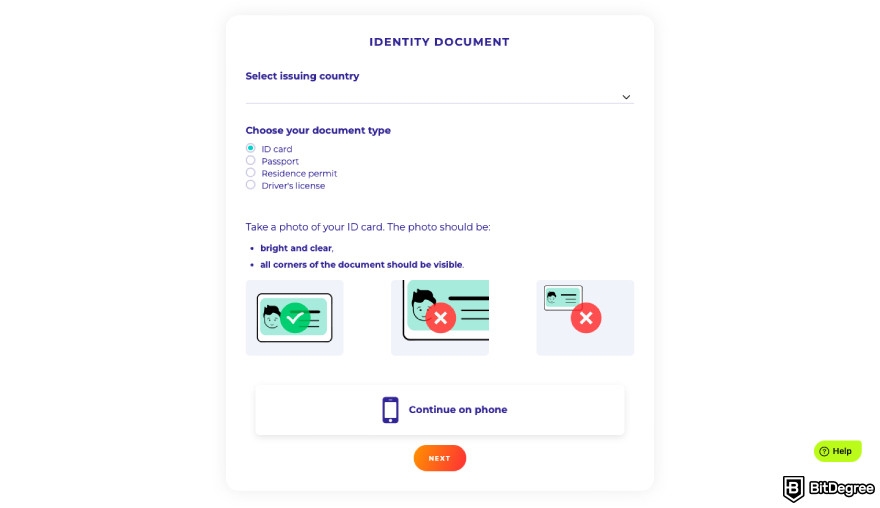 Escrow is definitely not fool-proof, however – there are multiple ways of how it can be bypassed or otherwise fail. So what happens if you do get scammed on Paxful? This is where the dispute moderation team comes to the rescue. Paxful practices a “fair dispute” approach where both sides can submit evidence of misconduct.
Escrow is definitely not fool-proof, however – there are multiple ways of how it can be bypassed or otherwise fail. So what happens if you do get scammed on Paxful? This is where the dispute moderation team comes to the rescue. Paxful practices a “fair dispute” approach where both sides can submit evidence of misconduct.
Once the dispute is called, the moderators step in and try to sort things out with the help of “cutting-edge tools in AI, crypto forensics, and cross-platform analytics”, which includes reviewing your entire chat history.
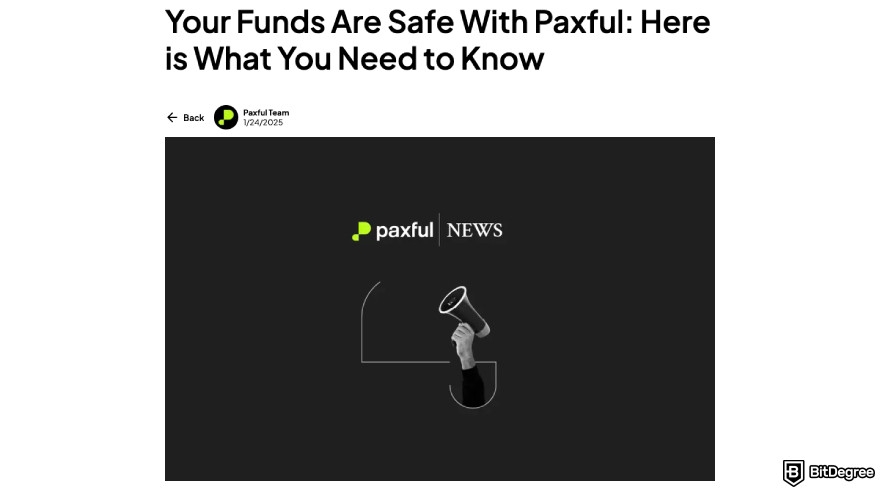 Of course, all of these safety nets require some degree of cooperation from the users – which is why Paxful has released a number of guides and tips on how to practice safe P2P trading. Most of it boils down to keeping all the communication on the platform, not canceling the trade once you’ve already paid, and making use of the trader badges and feedback scores to find the most reputable traders.
Of course, all of these safety nets require some degree of cooperation from the users – which is why Paxful has released a number of guides and tips on how to practice safe P2P trading. Most of it boils down to keeping all the communication on the platform, not canceling the trade once you’ve already paid, and making use of the trader badges and feedback scores to find the most reputable traders.
To round it up, Paxful employs a few other standard security measures, such as advanced encryption and multi-factor authentication.
Customer Support
I can’t stress enough that, on a crypto P2P marketplace like Paxful, customer support doesn’t actually play a supporting role but a leading one – it’s essentially the frontline battalion of the platform's security.
But I’ve already described this role in the previous section, so I might as well just fill in a few missing bits now. Both the web and mobile Paxful apps feature a live chatbot, as well as an option to contact the support team via email. You'll also find an extensive knowledge base.
 Paxful has several social media channels: X (formerly Twitter), Telegram, LinkedIn, Instagram, Facebook, YouTube, Discord, and TikTok.
Paxful has several social media channels: X (formerly Twitter), Telegram, LinkedIn, Instagram, Facebook, YouTube, Discord, and TikTok.
Speaking of social media, I can’t help but mention a concerning amount of negative Paxful reviews from disgruntled users I’ve seen all over their channels (though largely absent on TrustPilot, where Paxful has a score of 4.5). As usual, though, it’s probably best to take them with a grain of salt – after all, happy users are much less likely to comment. Lastly, it's worth noting that the company has stated that they don’t reply to feedback on social media.
Localization and Regional Adaptability
Since its launch in 2015, Paxful has expanded to over 140 countries, which puts it on par with most popular exchanges like Binance, Kraken, and Bybit.
Unfortunately, users from certain countries get the short end of the stick due to international sanctions or regulatory issues. The list of restricted countries and regions includes the US, Canada, Iran, Russia, Belarus, Cyprus, and 60+ other countries.
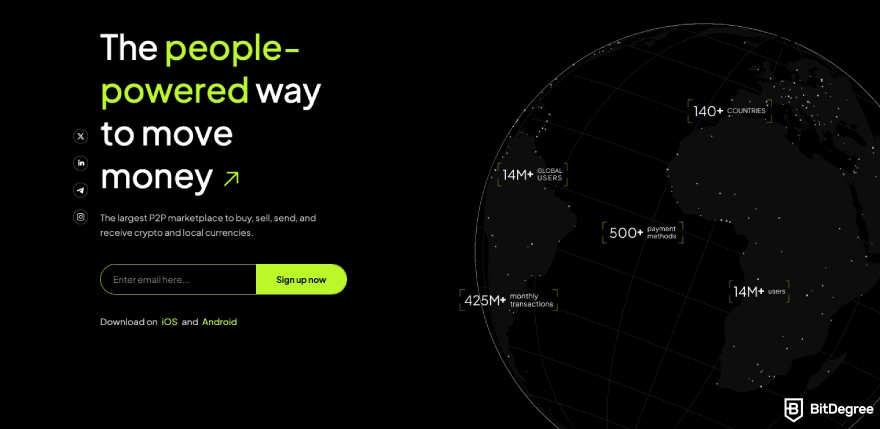 Despite not operating in the US anymore, Paxful is still based in North Carolina and is regulated by a number of US authorities, namely, the US Treasury Department’s Financial Crimes Enforcement Network (FinCEN) and Office of Foreign Assets Control (OFAC). Paxful is not officially licensed in any of the countries where it's currently available.
Despite not operating in the US anymore, Paxful is still based in North Carolina and is regulated by a number of US authorities, namely, the US Treasury Department’s Financial Crimes Enforcement Network (FinCEN) and Office of Foreign Assets Control (OFAC). Paxful is not officially licensed in any of the countries where it's currently available.
Bonuses and Special Offers
Paxful has two types of reward programs:
- Affiliate program;
- Trader program.
The first one is essentially a referral system – every user gets a link they can send to a friend, inviting them to join the platform. As soon as the referee completes the Paxful sign-up process and places their first order, they officially become a member of your affiliate network, and you become eligible for a 50% commission on their escrow fees.
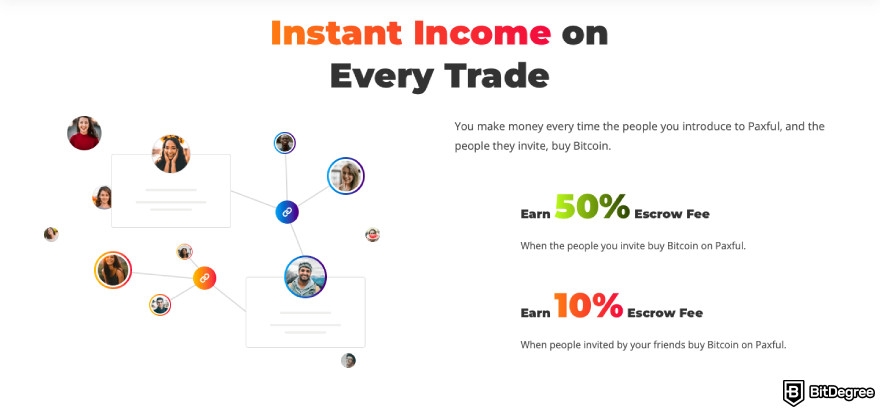 On top of that, you get a 10% commission on “second-degree” referrals – that is, the people your referees get on board!
On top of that, you get a 10% commission on “second-degree” referrals – that is, the people your referees get on board!
You can withdraw your earnings from your Paxful Wallet as soon as you accumulate the equivalent of at least $10.
The Trader program, on the other hand, rewards active users with a high trading volume. The program has two tiers – Power Traders and Expert Traders. Both have to meet the following criteria:
- Follow Paxful’s Terms of Service;
- Have an account for at least 90 days;
- Pass the ID and proof of address verification;
- Pass the internal verification;
- Carry out at least 250 trades every 90 days (1000 for Expert Traders);
- Have at least 125 trade partners every 90 days.
Both tiers come with a set of perks and benefits, including a badge on your profile, priority support, lower fees, access to beta features, and additional promotions for your offers.
📚 Read More: Best Crypto Affiliate Programs
How to Use Paxful
Now that we've gotten questions like “What is Paxful?” and “Is Paxful legit?” out of the way, we’re overdue for a hands-on practice session! Let me show you how to get started with this platform.
The following tutorials are meant for the web version, but you can download the mobile Paxful app and recreate the same steps there if you want to – it’s just as accessible and easy to use as the desktop version.
How to Create a Paxful Account
The Paxful sign-up process is no different than what you’d find on most other similar platforms. Still, I’m nothing if not thorough – so here’s the checklist:
Step 1: Click [Register] in the top right corner of the Paxful homepage.
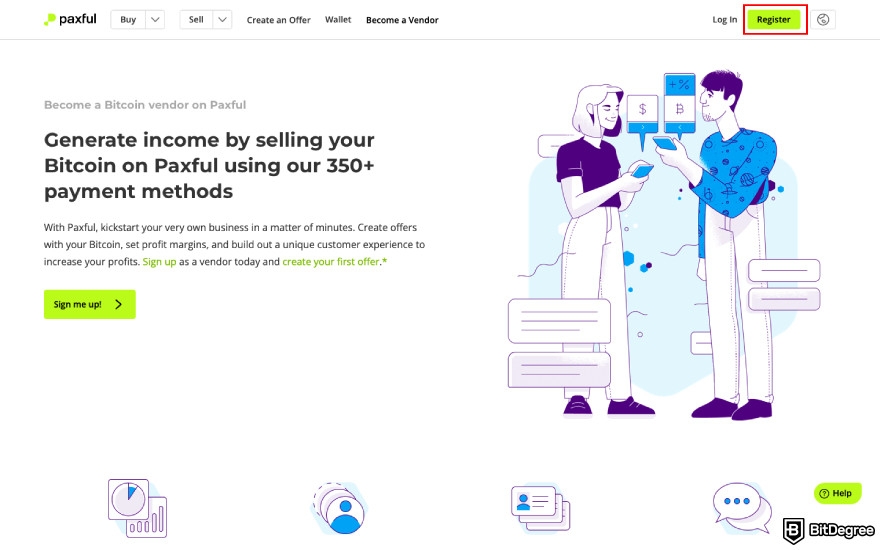 Step 2: Check the box and wait to be redirected to the registration form.
Step 2: Check the box and wait to be redirected to the registration form.
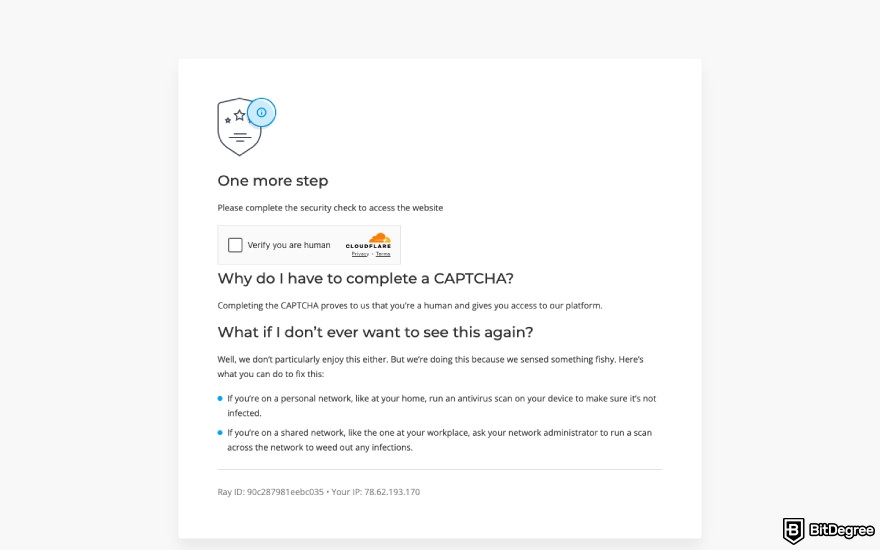 Step 3: Fill in your email address and create a password on the sign-up form, then click [Create Account].
Step 3: Fill in your email address and create a password on the sign-up form, then click [Create Account].
 Step 4: Complete the CAPTCHA verification.
Step 4: Complete the CAPTCHA verification.
 Step 5: Type in your Paxful login details.
Step 5: Type in your Paxful login details.
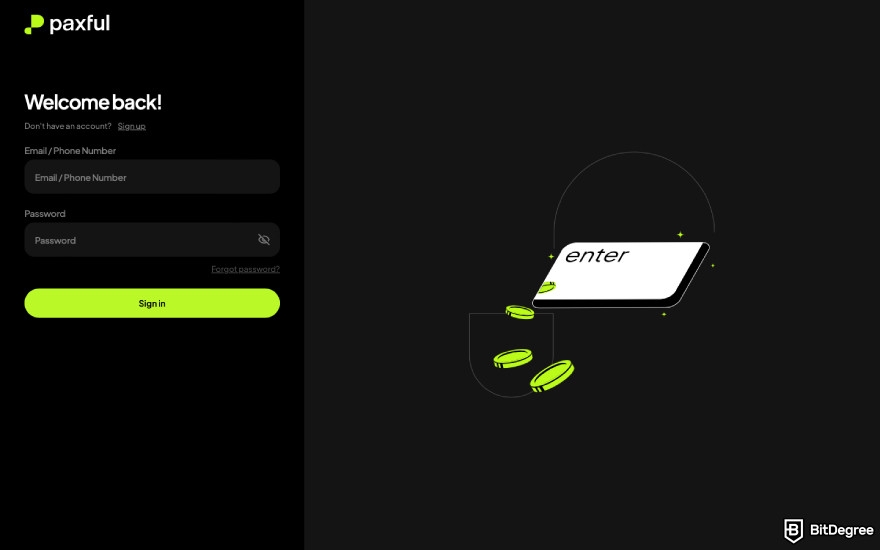 That’s it – at least for the initial part. That said, as I've already mentioned, you’re pretty much stuck in place without completing KYC. You’ll see a reminder on your dashboard or in the settings under the “Security” tab. Click it, and you’ll be redirected to the verification page. It should only take a few minutes at most. After that, you’ll be sent to the Paxful login page again.
That’s it – at least for the initial part. That said, as I've already mentioned, you’re pretty much stuck in place without completing KYC. You’ll see a reminder on your dashboard or in the settings under the “Security” tab. Click it, and you’ll be redirected to the verification page. It should only take a few minutes at most. After that, you’ll be sent to the Paxful login page again.
How to Deposit on Paxful
Once you’re all settled, you’ll probably want to get some crypto into your account next, in case you want to use it as a payment method. Here’s how to do it:
Step 1: From your dashboard or settings page, click [Wallet] on the top menu bar.
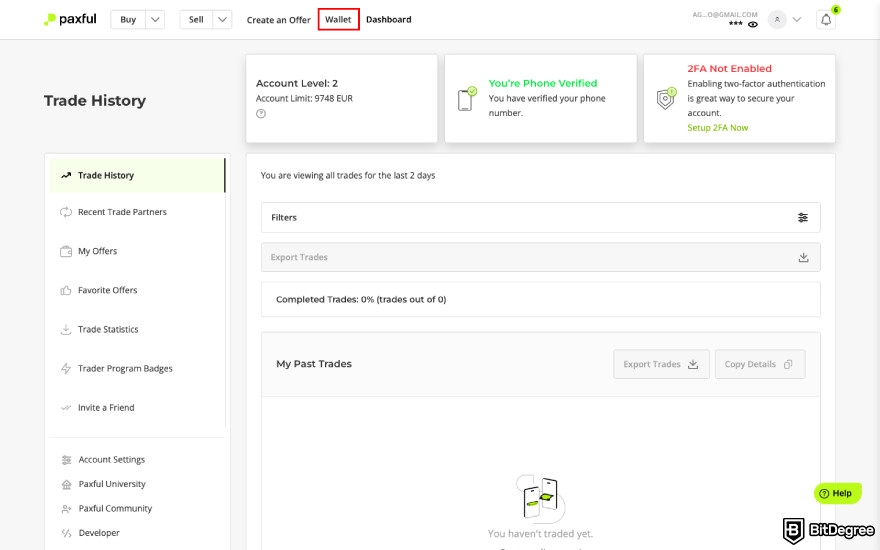 Step 2: Choose the coin you want to deposit and click the [Receive] button next to it.
Step 2: Choose the coin you want to deposit and click the [Receive] button next to it.
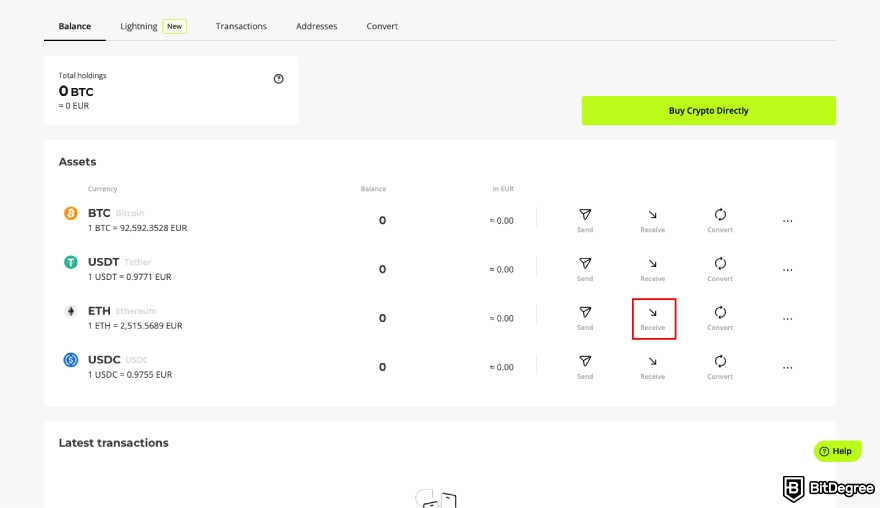 Step 3: Copy the provided address to the wallet you’re depositing from.
Step 3: Copy the provided address to the wallet you’re depositing from.
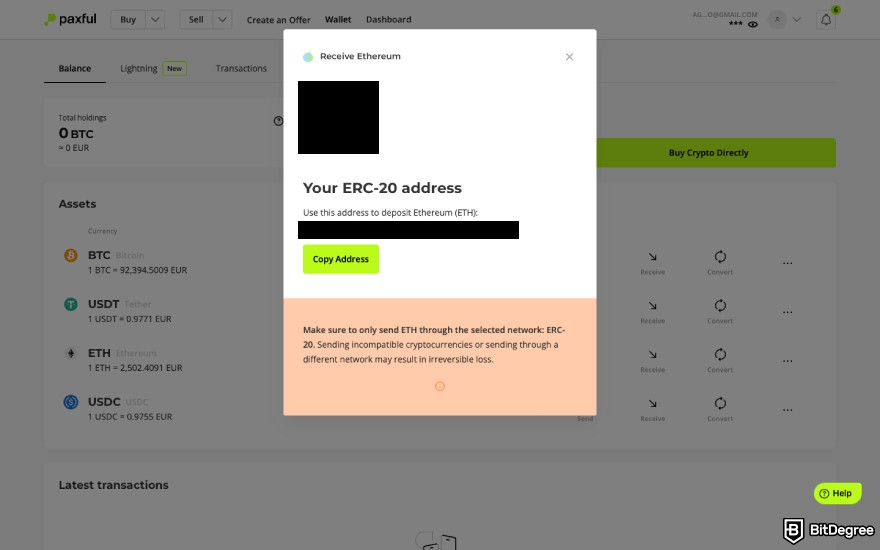 Here we go! You should see the funds in your Paxful wallet within a few minutes.
Here we go! You should see the funds in your Paxful wallet within a few minutes.
Sign up on Binance and claim up to $600 worth of rewards for completing simple tasks. Use Binance referral code (49316610) to activate the offer while it's still valid!
How to Withdraw From Paxful
There’d be no point in teaching you how to deposit if I didn’t include a guide to getting your crypto off the platform, too, right? Here it comes:
Step 1: From your dashboard or settings page, click [Wallet] on the top menu bar.
 Step 2: Choose the coin you want to withdraw and click the [Send] button next to it.
Step 2: Choose the coin you want to withdraw and click the [Send] button next to it.
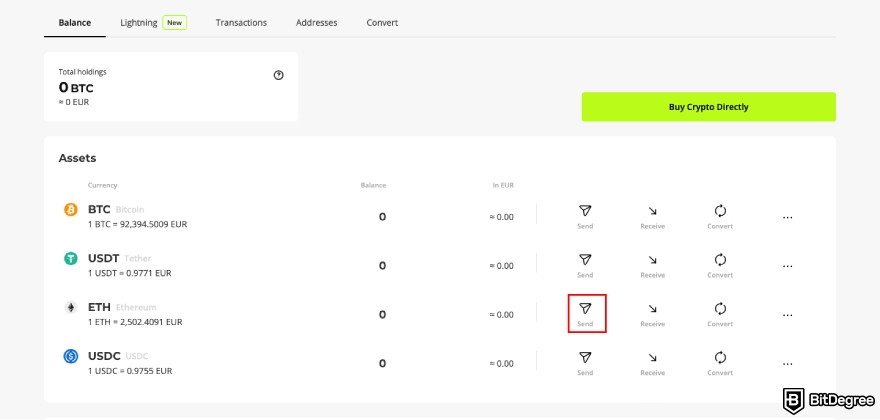 Step 3: Paste the withdrawal wallet address, enter the amount you want to withdraw (it has to be the equivalent of at least $1), and click [Continue].
Step 3: Paste the withdrawal wallet address, enter the amount you want to withdraw (it has to be the equivalent of at least $1), and click [Continue].
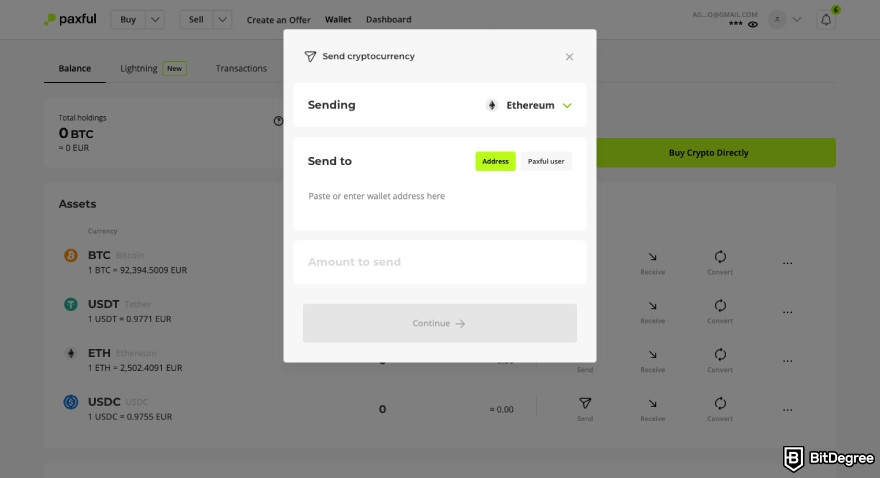 All done!
All done!
As a side note, you can also send crypto to another Paxful user (or your own alternative account), in which case you can either paste the address or simply type in the username.
Comparison to Other Popular Exchanges
When it comes to standalone P2P platforms, Paxful is definitely one of the heavyweights – but can it hold its own against centralized exchanges like Bybit and KuCoin, which have long become household names in the industry? Let’s take a closer look at these top-rated Paxful alternatives.
Paxful VS Bybit
Launched in 2018, Bybit has over 10 million users across 160+ countries and a whole array of trading types: spot, margin, futures, options, pre-market, copy trading, a DEX, and a P2P marketplace.
Bybit’s P2P selection features the same four coins you’ll find on Paxful. It offers over 300 payment methods, putting it on par with our platform in question – although the list doesn’t include other cryptocurrencies. Bybit gets the medal for affordability, though. Both buyers and sellers can trade on its P2P platform with no additional fees.
 If you’re looking to buy and sell something other than the above-mentioned coins, you have a lot more options on the table. Bybit’s spot trading platform supports a whopping 1,600+ cryptocurrencies. You can also try your hand at futures trading with USDT or USDC-margined perpetual contracts. Unlike most exchanges, Bybit includes standard futures contracts with an expiration date.
If you’re looking to buy and sell something other than the above-mentioned coins, you have a lot more options on the table. Bybit’s spot trading platform supports a whopping 1,600+ cryptocurrencies. You can also try your hand at futures trading with USDT or USDC-margined perpetual contracts. Unlike most exchanges, Bybit includes standard futures contracts with an expiration date.
While P2P trading is free on Bybit, spot trading has a 0.1% fee for both takers and makers, which makes it a much more affordable option than Paxful if all you want to do is trade one crypto for another. Perpetuals and future trading cost 0.0550% for takers and 0.0200% for makers.
📚 Read More: Bybit Review
Paxful VS KuCoin
With its 34+ million users, KuCoin is one of the most popular crypto exchanges that supports spot, margin, pre-market, options, and futures trading. As a cherry on top, KuCoin features a P2P marketplace among its crypto buying/selling options.
KuCoin’s P2P crypto list includes BTC, ETH, USDT, USDC, and KCS (KuCoin’s native token). You can choose to pay with over 70+ fiat currencies or 24 other payment methods, such as credit/debit card, Apple Pay, or SEPA. Between Paxful and KuCoin, the latter comes out as a less flexible alternative for P2P trading, but it takes the gold when it comes to pricing – just like Bybit, KuCoin charges no P2P trading fees.
 If you’d rather trade other coins and tokens, though, KuCoin comes with a full-fledged spot trading platform featuring over 900 cryptocurrencies. You’ll also find margin trading with up to 3x leverage and a particularly versatile futures trading package with three types of perpetual contracts: USDT, USDC, and coin-margined.
If you’d rather trade other coins and tokens, though, KuCoin comes with a full-fledged spot trading platform featuring over 900 cryptocurrencies. You’ll also find margin trading with up to 3x leverage and a particularly versatile futures trading package with three types of perpetual contracts: USDT, USDC, and coin-margined.
KuCoin charges a 0.1% spot trading fee for both makers and takers. If you have any KCS in your account, it drops down to only 0.08% – but even the standard non-VIP fee is still a lot less than what you’d pay as a seller on Paxful.
📚 Read More: KuCoin Review

- Secure and reliable
- Accepts fiat currencies
- Lots of trading options
- Reputable exchange
- Accepts fiat currencies
- Offers various trading options

- Fiat currencies - accepted
- Simple to use
- Accepts only the most trustworthy cryptocurrencies
- A leading cryptocurrency exchange platform
- Best for beginner investors
- Accepts fiat currencies

- Fully reserved and transparent
- Multiple tradable asset classes
- Over 300 supported cryptos
- Over 300 cryptocurrencies
- Secure & transparent
- Fully reserved
Conclusions: Is Paxful Right for You?
This is it for my Paxful review! If you’re curious to give P2P trading a go, Paxful is one of the most reliable platforms for both beginners and seasoned traders. It’s got everything you need – a seamless and accessible interface to help you narrow down the offers, tons of payment options, and robust security and customer support to tackle the inherent risks of peer-to-peer crypto trading.
Still, there’s a shortcoming or two that might give you second thoughts. If you’re partial to anything else than BTC, ETH, or stablecoins, Paxful won’t have much to offer. Seller fees seem outrageously high compared to many other platforms, too.
The content published on this website is not aimed to give any kind of financial, investment, trading, or any other form of advice. BitDegree.org does not endorse or suggest you to buy, sell or hold any kind of cryptocurrency. Before making financial investment decisions, do consult your financial advisor.
Scientific References
1. Kabašinskas A., Šutienė K.: 'Key Roles of Crypto-Exchanges in Generating Arbitrage Opportunities';
2. Tsuchiya T., Cuevas A., Christin N.: 'Identifying Risky Vendors in Cryptocurrency P2P Marketplaces'.






